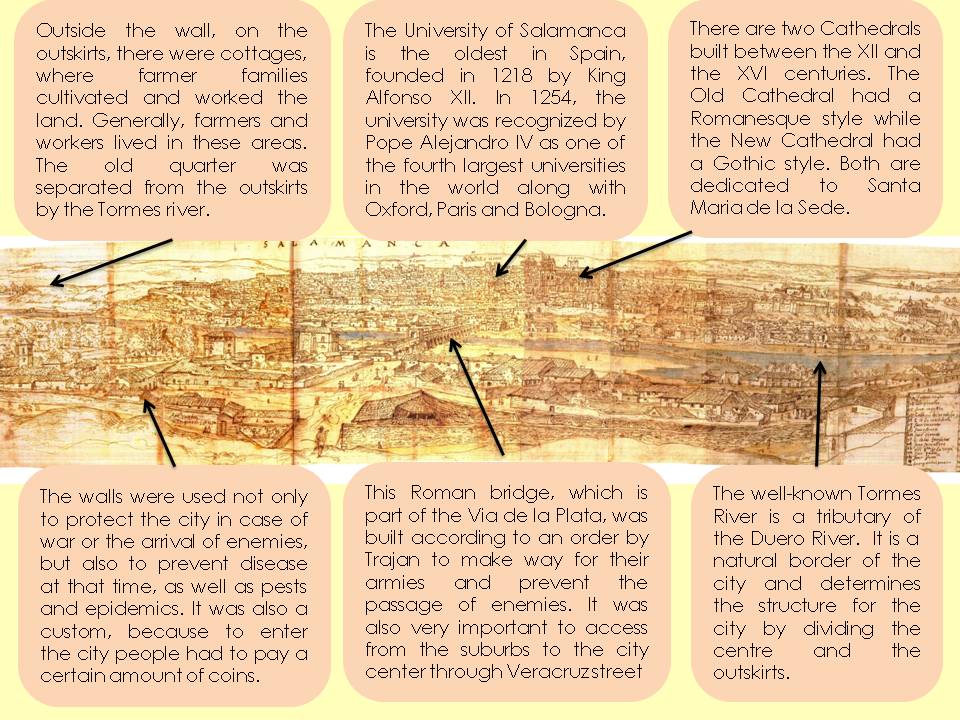SALAMANCA (Anton Van Den Wyngaerde, 1570)
This is a drawing that represents a view of Salamanca from El Arrabal, in 1570. It was made by Anton Van Den Wyngaerde in 1570 and has been collected for a project by Silvia García Alcázar and Fernando González Moreno at the University of Castilla and León. Wyngaerde was a Flemish artist who was commissioned by King Felipe II to visit Spain and draw a number of views of many Spanish cities between 1561 and 1570.
Salamanca is located in the Comunidad Autónoma de Castilla y Leon. Its origins are dated about 2,700 years ago during the Early Iron Age, when the first people who inhabited this land settled on the hill of San Vicente, on the banks of the Tormes river. Since that moment, the city has been inhabited by different people, such as Vacceos, Romans, Visigoths and Muslims. Raimundo of Borgoña, son of King Alfonso VI of Leon, was in charge of repopulating the city during the Middle Ages and laid the foundations for the current Salamanca.
As we can see in the engraving, there are three parts in the city: the old quarter, the outskirts and the Tormes river, which was used as a natural border as well as a way of defense. The town has a typical medieval structure, which means that does not have a fixed pattern as conform to the historical and geographical circumstances. The streets have an irregular layout, but are organized with the aim of forming a unitary space. In addition, this type of cities is organized in neighborhoods that each has often his own political organization. Usually, in the city center lived the rich people with high purchasing power, while the poorest occupied the outskirts, outside the walls. The construction of city walls aimed to protect and defend the town. They were built around the city to protect citizens from possible diseases, epidemics or potential wars and attack enemies. In the picture it is possible to appreciate some gates in the city wall (Gate of Zamora, Gate of Toro, Gate of Sancti Spiritus), as well as a number of cottage located outside the wall above left.
In this picture it is shown the Old Cathedral of Salamanca, founded by Bishop Jeronimo of Perigord, the first bishop of the Diocese of Salamanca. As a curiosity, the Cathedral originally had three naves, semicircular apses and a famous garland dome in the transept as it was common in Romanesque style. The cathedral also has two towers at the foot. Later, it was constructed a second Cathedral in Gothic style, joined to the previous one. That is a truly rarity in Art History.
Near the Cathedral we can see the University of Salamanca. It is one of the oldest universities in Spain, founded in 1218 by King Alfonso IX. In this university some teachers have taught distinguished classes throughout history, such as Fray Luis de León, Beatriz Galindo, Melchor Cano, Francisco de Vitoria and Miguel Unamuno. A surprising fact is that within the halls of this university many important figures that have passed into history, for example Miguel de Cervantes, Hernando Cortes and Christopher Columbus.
In the image we can also see the Roman bridge crossing the Tormes river and being part of the Via de la Plata, one of most important ancient Roman roads. This bridge is made of stone, much of it rebuilt by King Felipe IV in 1677. The Tormes river is a tributary of the Duero river; it starts in Avila province and flows into the Duero river. It is very important for the city of Salamanca because it works for water supply and many women washed their clothes down the river. Both the bridge and the river has been featured in famous works of literature such as Lazarillo de Tormes. In the XVI Century, Salamanca was a very important city thanks to its university and also its cattle fair and other commercial activities. It was the Golden Age for the city.
Paula Cecilia González

